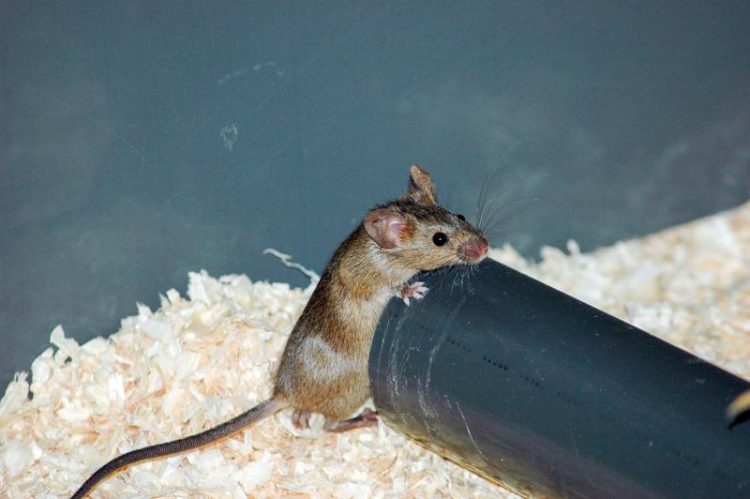Sick animals limit disease transmission by isolating themselves from their peers

By removing themselves from the group sick mice limit disease spread. Image: UZH
When animals get sick, they may change their behaviour, becoming less active, for example. The study’s lead author, Patricia Lopes from the Department of Evolutionary Biology and Environmental Studies at the University of Zurich, says that previous research in wild animals has generally ignored how this change in behaviour may affect social contacts in a group and how, in turn, these changes can impact the transmission of a disease.
Sick mice are not avoided, but remove themselves from the group
To tackle this problem, Patricia Lopes and her colleagues used a novel combination of experimental manipulations of free-living mice, radio frequency tracking of animals, social network analysis and disease modelling.
To simulate an infection, mice were injected with lipopolysaccharides (a component of the bacterial cell wall), which results in an immune response and generalized disease symptoms. In a paper published this week in the journal Scientific Reports, the team reveals that sick mice become disconnected from their social groups.
It is known that mice have the ability to detect other sick mice. Therefore, it was surprising to find that the animals in the same social group did not avoid the sick mouse. In fact, they went on interacting with the sick mouse and other mice more or less in the same way as before the experimental infection. “It was the sick mouse that removed itself from the group”, emphasizes Lopes. She suggests that such a change in the behaviour of the sick mouse may protect relatives in the same group from catching the disease, which could be beneficial from an evolutionary perspective.
Speed and extent of disease spread are greatly reduced
In a further step, the researchers used mathematical models to predict how an infectious disease would spread considering the changes in behaviour of the sick animals. “When we account for the behavioural changes and how they affect social contacts, we find that the speed and the extent of disease spread are greatly reduced,” says Lopes.
Ultimately, the study contributes to our understanding of the complexity inherent to disease transmission and highlights the importance of changes in behaviour of sick animals for predicting the outcome of outbreaks. The findings extend to humans, as humans are also known to alter their behaviours when sick. Such effects are possible in a number of diseases spread by social contact where contagiousness overlaps with behavioural symptoms, including influenza and Ebola. Understanding why we feel sick and how diseases spread is a pressing issue, particularly given projected increases in disease outbreak driven by the synergy of climate change, habitat disturbance and human connectivity.
Literature:
Patricia C. Lopes, Per Block and Barbara König. Infection-induced behavioural changes reduce connectivity and the potential for disease spread in wild mice contact networks. Scientific Reports. August 22, 2016. doi: 10.1038/srep31790
Contact:
Dr. Patricia C. Lopes
Department of Evolutionary Biology and Environmental Studies
University of Zurich
Phone: +41 44 635 52 77
E-mail: patricia.lopes@ieu.uzh.ch
http://www.media.uzh.ch/en/Press-Releases/2016/sick-mice.html
Media Contact
All latest news from the category: Life Sciences and Chemistry
Articles and reports from the Life Sciences and chemistry area deal with applied and basic research into modern biology, chemistry and human medicine.
Valuable information can be found on a range of life sciences fields including bacteriology, biochemistry, bionics, bioinformatics, biophysics, biotechnology, genetics, geobotany, human biology, marine biology, microbiology, molecular biology, cellular biology, zoology, bioinorganic chemistry, microchemistry and environmental chemistry.
Newest articles

Compact LCOS Microdisplay with Fast CMOS Backplane
…for High-Speed Light Modulation. Researchers from the Fraunhofer Institute for Photonic Microsystems IPMS, in collaboration with HOLOEYE Photonics AG, have developed a compact LCOS microdisplay with high refresh rates that…

New perspectives for material detection
CRC MARIE enters third funding period: A major success for terahertz research: Scientists at the University of Duisburg-Essen and the Ruhr University Bochum have been researching mobile material detection since…

CD Laboratory at TU Graz Researches New Semiconductor Materials
Using energy- and resource-saving methods, a research team at the Institute of Inorganic Chemistry at TU Graz aims to produce high-quality doped silicon layers for the electronics and solar industries….



